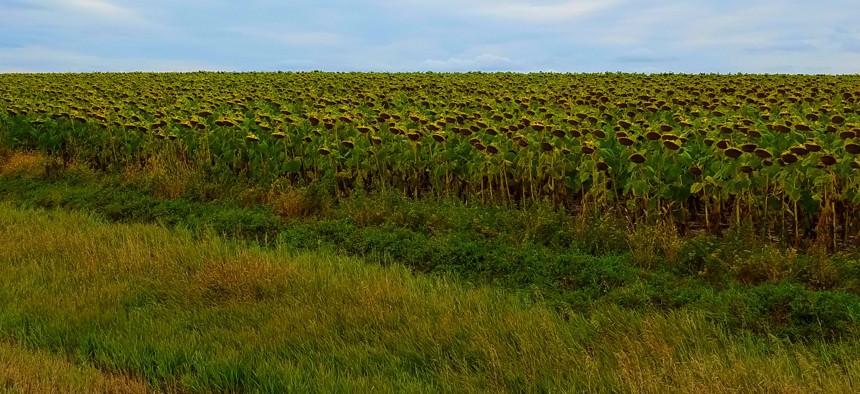Route Fifty Roadmap: Venturing Into the Heart of Sunflower Country

A sunflower field nears harvest time near Akaska, South Dakota. Route Fifty Photo
Harvest time nears in a desolate part of South Dakota, traditionally the nation’s most productive area for sunflowers.
Route Fifty Roadmap is an ongoing series of dispatches from the semi-regular travels of the Route Fifty staff around the United States. | PREVIOUSLY: Madison, Wis.
AKASKA, S.D. — State Highway 1804, a winding scenic route that roughly parallels the Missouri River, officially ends about 5 miles northwest of this tiny South Dakota town that has less than 50 residents. At the point where the pavement ends and gravel begins, a road sign notes that the state-maintained highway will eventually start again.
But that gap, as I discovered while recently driving from Bismarck, North Dakota, to Pierre, South Dakota, means you’re venturing for about 40 minutes through a rural and desolate part of the Great Plains on a dusty, unpaved road—something I didn’t realize when choosing this meandering route, which offered beautiful periodic views of the river, to go from one state capital to the other. Road trips should be adventurous, right?
Trying to connect back up with Highway 1804 to continue onto Pierre, I passed one pickup truck along the way. There were no gas stations, no landmarks or tourist attractions. For the traveler, there’s not much of anything in this part of South Dakota, except striking agricultural landscapes, if that’s what you’re seeking.
There are also a lot of sunflowers.
In fact, many of the counties in this part of South Dakota are home to some of the most productive sunflower fields in the United States—Sully County, just to the south of Walworth County, where Akaska is located, has either been the nation’s top-producing county, or near the top of national sunflower production rankings, for many years.
That’s helped South Dakota lead the nation in sunflower production for the past three years, besting Kansas, the so-called Sunflower State, which is fourth behind Minnesota and North Dakota.
In 2015, South Dakota sunflower producers averaged 1,858 pounds per acre, according to the Capital Journal, while the average in Kansas was 1,784 pounds per acre.
Driving along the dusty roads that would eventually lead back to Highway 1804, you can get a close-up look at the sunflower fields. This time of year, as farmers are preparing to harvest, sunflowers look a bit forlorn, with their heads turning brown and drooping downward.

They’re in the process of drying out. Too much moisture is bad, as is too little moisture. Farmers have tough calls to make as they make decisions about when harvest.
The outlook for 2016’s sunflower harvest?
According to Farm & Ranch Guide:
As of Sept. 12, [the U.S. Department of Agriculture] continued to rate the majority of the U.S. sunflower crop in good to excellent condition in all major production states.
In North Dakota, 73 percent of the crop was rated good/excellent with 23 percent rated fair and 6 percent poor/very poor. Twenty-two percent of the crop was considered mature, which compares to 12 percent at this time last year.
In Minnesota, 58 percent of the crop was in good/excellent condition and 37 percent fair, while in South Dakota the crop was rated 55 percent good/excellent and 38 percent fair.
So even though the skies were mostly cloudy when I was passing through, the situation is looking mostly sunny for this year’s sunflower crop.

Michael Grass is Executive Editor of Government Executive’s Route Fifty and is based in Seattle.
NEXT STORY: 'Pay-for-Performance' Aims to Save Money on High Drug Prices






